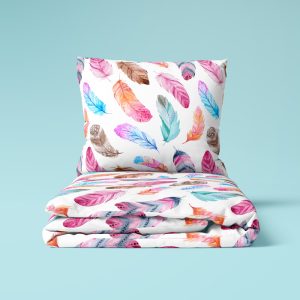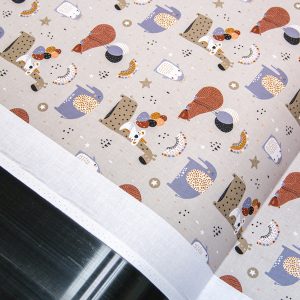Printing on fabrics is a crucial element in creating unique fashion collections. Unfortunately, even the most creative designs can be ruined by errors in the printing on fabrics process. This article will highlight 5 of the most common textile printing mistakes that fashion brands should avoid to ensure high textile printing quality and durable prints on their apparel.
Table of Content
- Why Is Fabric Printing Crucial for Fashion Brands?
- Mistake #1 – Choosing the Wrong Printing Technique
- Mistake #2 – Skipping Test Prints and Quality Control
- Mistake #3 – Improper File Preparation
- Mistake #4 – Ignoring Fabric Characteristics
- Mistake #5 – Overlooking Environmental and Safety Standards
- Conclusion – How to Avoid These Mistakes
Why Is Fabric Printing Crucial for Fashion Brands?
The quality of prints on clothing is fundamental to a brand’s image and how customers perceive its collections. In the fashion industry, where competition is incredibly intense, every detail, no matter how small, plays a significant role. High-quality prints are not just an aesthetic asset but, above all, a calling card for the brand, demonstrating its attention to detail, professionalism, and commitment to delivering products of the highest standard.
Mistake #1 – Choosing the Wrong Printing Technique
Numerous printing on fabrics methods exist, each with its specific applications. The most popular include:
- Screen Printing: This traditional technique involves forcing ink through a screen onto the fabric. It’s ideal for large runs and simple designs, providing durable and vibrant colors. Plastisol inks used in screen printing are thicker and more opaque, creating a raised print effect. Screen printing is often used for printing on cotton t-shirts, sweatshirts, and bags.
- Pigment Printing: This modern digital technique involves directly applying pigments onto the fabric. It’s precise and versatile, allowing for the printing of complex designs and photographs. Pigment printing is more environmentally friendly than screen printing as it uses less water and energy. It’s ideal for printing on cotton, linen, and viscose.
- Sublimation: This technique involves transferring a design from paper to fabric under high temperature. It’s ideal for polyester fabrics, providing durable and vivid colors that penetrate the material’s structure. Sublimation is often used for printing on sportswear, flags, and banners.
Choosing the appropriate method depends on the fabric type, design, and production volume. An incorrect printing technique can lead to low quality and non-durable prints, representing a significant printing mistake.

Mistake #2 – Skipping Test Prints and Quality Control
Before starting mass production, it’s essential to create prototypes and test samples. This allows for the detection of potential errors and shortcomings. A lack of quality checks can result in low quality and customer dissatisfaction. This is one of the critical steps to avoid printing errors.
Why are quality checks so important?
- Color Verification: Tests allow you to check if the colors on the print match the colors in the graphic design.
- Print Durability Assessment: Samples can be subjected to washing, drying, and other tests to check how the print behaves under usage conditions.
- Detail Quality Check: Tests allow you to assess whether fine details of the design are reproduced with adequate precision.
- Minimizing the Risk of Losses: Detecting errors during prototyping helps avoid print production mistakes and costly corrections in mass production.
Mistake #3 – Improper File Preparation
Preparing the file for printing is crucial for the final result. Attention should be paid to:
- Resolution: Too low an image resolution leads to blurry and pixelated prints. It’s vital to ensure the recommended print resolution is met to achieve high-quality printed materials.
- Colors: The color palette should be adjusted to the printing on fabrics technique (CMYK for digital printing, Pantone colors for screen printing). Using the correct CMYK colour space is essential to avoid prepress errors.
- File Formats: The best formats are vector (AI, EPS) or raster (TIFF, PNG) with high-resolution images. Incorrect prepress file formats can lead to printing mistakes occur.
The quality of the files directly impacts the print quality. Understanding prepress file formats is key to avoid business printing errors.
Mistake #4 – Ignoring Fabric Characteristics
Each fabric type has different properties that affect the print result. The following should be considered:
- Cotton: Ideal for pigment printing and screen printing.
- Polyester: Excellent for sublimation.
- Blends: Require specialized knowledge and experience.
Improper fabric preparation can lead to stretching, fading, and other defects, highlighting why understanding fabric properties helps avoid printing errors.
Mistake #5 – Overlooking Environmental and Safety Standards
Pigment printing on clothing is more environmentally friendly than traditional printing methods. It’s worth choosing printing houses that use water-based inks and have ecological certifications (OEKO-TEX, GOTS). High-quality fabrics and ecological printing build a positive brand image. Safety checks are also crucial.
Why are ecology and safety important?
- Brand Image: Customers increasingly pay attention to the ecological and ethical aspects of production.
- Customer Health: Certifications like OEKO-TEX guarantee that fabrics are free from harmful substances.
- Environmental Protection: Using water-based inks and ecological materials minimizes the negative impact on the environment.
- Legal Regulations: Some countries have regulations governing the use of harmful substances in textiles.
Conclusion – How to Avoid These Mistakes
- Choose the appropriate printing technique for the fabric type and design.
- Create prototypes and test samples before mass production.
- Prepare design files according to the printer’s requirements, ensuring optimal print file specifications and the recommended print resolution.
- Match the design to the properties of the fabric.
- Choose printing houses that care about ecology and safety.
Collaborating with an experienced printing house and designer is key to obtaining high-quality prints and durable printing on fabrics for fashion brands. Paying attention to details like image resolution, bleed settings, and understanding the printing process will help avoid print production mistakes and ensure creating print quality in your collections. Always check print settings and include print guides when providing your design file to prevent commonest print mistakes.





